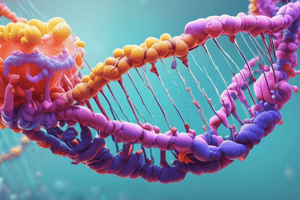Podcast
Questions and Answers
What is the primary function of DNA methylation?
What is the primary function of DNA methylation?
- Gene activation
- Chromatin remodeling
- Gene silencing (correct)
- Histone modification
Which of the following is an example of epigenetic inheritance?
Which of the following is an example of epigenetic inheritance?
- Gene expression via transcription factors
- Epigenetic reprogramming
- Transmission of genetic mutations
- Transmission of epigenetic marks from parent to offspring (correct)
What is the primary application of epigenomics in cancer research?
What is the primary application of epigenomics in cancer research?
- Studying gene expression
- Understanding genetic mutations
- Analyzing genome structure
- Investigating epigenetic changes in tumor development (correct)
What is the primary focus of epigenomics?
What is the primary focus of epigenomics?
Which epigenomics technique is used to map epigenetic marks to specific genomic locations?
Which epigenomics technique is used to map epigenetic marks to specific genomic locations?
What is the result of chromatin remodeling?
What is the result of chromatin remodeling?
Which of the following is an application of epigenomics in agricultural science?
Which of the following is an application of epigenomics in agricultural science?
What is the main effect of DNA methylation on gene expression?
What is the main effect of DNA methylation on gene expression?
Which epigenomic technology is used to measure DNA methylation levels across the entire genome?
Which epigenomic technology is used to measure DNA methylation levels across the entire genome?
What is the purpose of epigenetic reprogramming?
What is the purpose of epigenetic reprogramming?
What is the purpose of histone modifications in epigenomics?
What is the purpose of histone modifications in epigenomics?
In which field of study is epigenomics used to investigate epigenetic changes associated with neurological disorders?
In which field of study is epigenomics used to investigate epigenetic changes associated with neurological disorders?
Which of the following is NOT a type of epigenetic mark?
Which of the following is NOT a type of epigenetic mark?
What is the primary advantage of Reduced Representation Bisulfite Sequencing (RRBS) over Whole-Genome Bisulfite Sequencing (WGBS)?
What is the primary advantage of Reduced Representation Bisulfite Sequencing (RRBS) over Whole-Genome Bisulfite Sequencing (WGBS)?
Flashcards are hidden until you start studying
Study Notes
Epigenomics
Definition
- Study of epigenetic changes, which are chemical modifications to DNA or histone proteins that can affect gene expression without altering the underlying DNA sequence.
Key Concepts
- Epigenetic marks: chemical modifications to DNA or histone proteins that can be inherited through cell division.
- Epigenetic inheritance: transmission of epigenetic marks from parent to offspring.
- Epigenetic reprogramming: erasure of epigenetic marks during gametogenesis or embryogenesis.
Epigenetic Mechanisms
- DNA Methylation: addition of a methyl group to cytosine residues in CpG islands, leading to gene silencing.
- Histone Modification: addition of various chemical groups (e.g., methyl, acetyl) to histone proteins, affecting chromatin structure and gene expression.
- Chromatin Remodeling: reorganization of chromatin structure to alter gene accessibility.
Epigenomics Techniques
- ChIP-Seq (Chromatin Immunoprecipitation Sequencing): mapping epigenetic marks to specific genomic locations.
- Bisulfite Sequencing: detecting DNA methylation at single-base resolution.
- ATAC-Seq (Assay for Transposase-Accessible Chromatin Sequencing): identifying open chromatin regions.
Epigenomics Applications
- Cancer Research: studying epigenetic changes in tumor development and progression.
- Developmental Biology: understanding epigenetic regulation of gene expression during development.
- Stem Cell Biology: investigating epigenetic mechanisms in stem cell maintenance and differentiation.
- Agricultural Science: improving crop yield and disease resistance through epigenetic modification.
Epigenomics
Definition
- Epigenomics is the study of epigenetic changes, which are chemical modifications to DNA or histone proteins that can affect gene expression without altering the underlying DNA sequence.
Key Concepts
- Epigenetic marks are chemical modifications to DNA or histone proteins that can be inherited through cell division.
- Epigenetic inheritance is the transmission of epigenetic marks from parent to offspring.
- Epigenetic reprogramming is the erasure of epigenetic marks during gametogenesis or embryogenesis.
Epigenetic Mechanisms
- DNA methylation is the addition of a methyl group to cytosine residues in CpG islands, leading to gene silencing.
- Histone modification is the addition of various chemical groups (e.g., methyl, acetyl) to histone proteins, affecting chromatin structure and gene expression.
- Chromatin remodeling is the reorganization of chromatin structure to alter gene accessibility.
Epigenomics Techniques
- ChIP-Seq (Chromatin Immunoprecipitation Sequencing) is used to map epigenetic marks to specific genomic locations.
- Bisulfite sequencing is used to detect DNA methylation at single-base resolution.
- ATAC-Seq (Assay for Transposase-Accessible Chromatin Sequencing) is used to identify open chromatin regions.
Epigenomics Applications
- Epigenomics is used in cancer research to study epigenetic changes in tumor development and progression.
- Epigenomics is used in developmental biology to understand epigenetic regulation of gene expression during development.
- Epigenomics is used in stem cell biology to investigate epigenetic mechanisms in stem cell maintenance and differentiation.
- Epigenomics is used in agricultural science to improve crop yield and disease resistance through epigenetic modification.
Epigenomics
- Epigenomics is the study of epigenetic changes across the entire genome.
Epigenetic Marks
- DNA Methylation: adds a methyl group to cytosine residues in CpG dinucleotides, leading to gene silencing.
- Histone Modifications: adds chemical groups (e.g., methyl, acetyl, phosphate) to histone proteins, affecting chromatin structure and accessibility.
Epigenomic Technologies
- ChIP-Seq: uses antibodies to pull down specific histone modifications or proteins, followed by sequencing to identify binding sites.
- Whole-Genome Bisulfite Sequencing (WGBS): measures DNA methylation levels across the entire genome.
- Reduced Representation Bisulfite Sequencing (RRBS): a cost-effective alternative to WGBS, focusing on specific genomic regions.
Epigenomic Applications
- Cancer Research: identifies epigenetic changes associated with tumorigenesis and potential therapeutic targets.
- Developmental Biology: studies epigenetic regulation of gene expression during development and cellular differentiation.
- Neurological Disorders: investigates epigenetic changes associated with neurological disorders, such as Alzheimer's disease and Parkinson's disease.
Studying That Suits You
Use AI to generate personalized quizzes and flashcards to suit your learning preferences.




